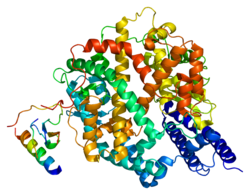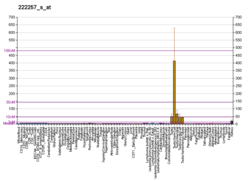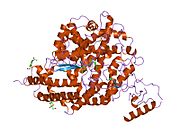Angiotensin-converting enzyme 2: Difference between revisions
→Coronavirus entry point: deleted unneeded wording |
|||
| Line 14: | Line 14: | ||
Alternative studies have suggested a close co-morbidity link between hypertension and heart disease and COVID-19 which may be related to these patients normally being prescribed ACE inhibitors, but that conflates ACE inhibitors and AT1R blockers. <ref>{{cite journal|doi=10.1016/S2213-2600(20)30116-8| vauthors =Fang L, Karakiulakis G, Roth M| title =Are patients with hypertension and diabetes mellitus at increased risk for COVID-19 infection?| journal =The Lancet Respiratory Medicine| year =2020}}</ref> In fact ACE inhibitors reduce hypertension and should be helpful. |
Alternative studies have suggested a close co-morbidity link between hypertension and heart disease and COVID-19 which may be related to these patients normally being prescribed ACE inhibitors, but that conflates ACE inhibitors and AT1R blockers. <ref>{{cite journal|doi=10.1016/S2213-2600(20)30116-8| vauthors =Fang L, Karakiulakis G, Roth M| title =Are patients with hypertension and diabetes mellitus at increased risk for COVID-19 infection?| journal =The Lancet Respiratory Medicine| year =2020}}</ref> In fact ACE inhibitors reduce hypertension and should be helpful. |
||
Treatment with angiotensin-converting enzyme (ACE) inhibitors results in an upregulation of ACE2,<ref name="pmid28619367">{{cite journal | vauthors = Li XC, Zhang J, Zhuo JL | title = The vasoprotective axes of the renin-angiotensin system: Physiological relevance and therapeutic implications in cardiovascular, hypertensive and kidney diseases | journal = Pharmacological Research | volume = 125 | issue = Pt A | pages = 21–38 | date = November 2017 | pmid = 28619367 | pmc = 5607101 | doi = 10.1016/j.phrs.2017.06.005 }}</ref> which is expressed by epithelial cells of the lung, intestine, kidney, and blood vessels. This increased expression of ACE2 may facilitate infection with SARS-CoV-2. Hence diabetes and hypertension treatment with ACE2-stimulating drugs may increase risk of COVID-19 infections.<ref name="pmid32171062">{{cite journal | vauthors = Fang L, Karakiulakis G, Roth M | title = Are patients with hypertension and diabetes mellitus at increased risk for COVID-19 infection? | journal = The Lancet. Respiratory Medicine | volume = | issue = | pages = | date = March 2020 | pmid = 32171062 | doi = 10.1016/S2213-2600(20)30116-8 }}</ref> |
|||
== See also == |
== See also == |
||
Revision as of 20:04, 17 March 2020
Angiotensin converting enzyme 2 (ACE2) is an exopeptidase that catalyses the conversion of angiotensin I to the nonapeptide angiotensin[1–9][5] or the conversion of angiotensin II to angiotensin 1–7.[6][7] It is a single-pass type I membrane protein expressed on the surface of epithelial cells of the pulmonary alveolus, and on small intestine enterocytes and other cell types.[8] ACE2 has direct effects on cardiac functiona and is expressed predominantly in vascular endothelial cells of the heart and the kidneys,[9] and also in epithelial cells of the lung and intestine. ACE2 is not sensitive to the ACE inhibitor drugs used to treat hypertension.[10]
Coronavirus entry point
ACE2 has been shown to be the entry point into human cells for some coronaviruses, including the SARS virus.[11] [12] A number of studies have identified that the entry point is the same for SARS-CoV-2,[13] the virus that causes COVID-19.[14][15][16][17]
This might lead some to suggest that decreasing the levels of ACE2, in cells, might help in fighting the infection, but that conflates ACE2 with the ACE2 receptor.[citation needed] More interestingly, ACE2 has been shown to have a protective effect against virus-induced lung injury by increasing the production of the vasodilator angiotensin 1–7.[18] In fact, the interaction of the spike protein of the virus with the ACE2 induces a drop in the levels of ACE2 in cells,[12] possibly inducing lung damage. Claims that the available (AT1R) blockers (Angiotensin II receptor blocker) such as losartan, can help in curing COVID-19 need to be tested by datamining of clinical patient records.[19] Suggestions that high dosage of Vitamin D, which has been shown to increase expression of ACE2 in cells,[20] could be effective in fighting the infection should be studied.[according to whom?] A possible way of combating the infection could be the injection of soluble ACE2 into the blood stream which will have the twofold effect of competing with cellular ACE2, preventing the attachment of the virus to non-infected cells and replenishing ACE2 in infected cells.[21]
Alternative studies have suggested a close co-morbidity link between hypertension and heart disease and COVID-19 which may be related to these patients normally being prescribed ACE inhibitors, but that conflates ACE inhibitors and AT1R blockers. [22] In fact ACE inhibitors reduce hypertension and should be helpful.
Treatment with angiotensin-converting enzyme (ACE) inhibitors results in an upregulation of ACE2,[23] which is expressed by epithelial cells of the lung, intestine, kidney, and blood vessels. This increased expression of ACE2 may facilitate infection with SARS-CoV-2. Hence diabetes and hypertension treatment with ACE2-stimulating drugs may increase risk of COVID-19 infections.[24]
See also
References
- ^ a b c GRCh38: Ensembl release 89: ENSG00000130234 – Ensembl, May 2017
- ^ a b c GRCm38: Ensembl release 89: ENSMUSG00000015405 – Ensembl, May 2017
- ^ "Human PubMed Reference:". National Center for Biotechnology Information, U.S. National Library of Medicine.
- ^ "Mouse PubMed Reference:". National Center for Biotechnology Information, U.S. National Library of Medicine.
- ^ Donoghue M, Hsieh F, Baronas E, Godbout K, Gosselin M, Stagliano N, et al. (September 2000). "A novel angiotensin-converting enzyme-related carboxypeptidase (ACE2) converts angiotensin I to angiotensin 1–9". Circulation Research. 87 (5): E1-9. doi:10.1161/01.res.87.5.e1. PMID 10969042.
- ^ Keidar S, Kaplan M, Gamliel-Lazarovich A (February 2007). "ACE2 of the heart: From angiotensin I to angiotensin (1-7)". Cardiovascular Research. 73 (3): 463–9. doi:10.1016/j.cardiores.2006.09.006. PMID 17049503.
- ^ Wang W, McKinnie SM, Farhan M, Paul M, McDonald T, McLean B, et al. (August 2016). "Angiotensin-Converting Enzyme 2 Metabolizes and Partially Inactivates Pyr-Apelin-13 and Apelin-17: Physiological Effects in the Cardiovascular System". Hypertension. 68 (2): 365–77. doi:10.1161/HYPERTENSIONAHA.115.06892. PMID 27217402.
- ^ Hamming, I; Timens, W; Bulthuis, MLC; Lely, AT; Navis, GJ; van Goor, H (June 2004). "Tissue distribution of ACE2 protein, the functional receptor for SARS coronavirus. A first step in understanding SARS pathogenesis". The Journal of Pathology. 203 (2): 631–637. doi:10.1002/path.1570.
- ^ Boehm M, Nabel EG (November 2002). "Angiotensin-converting enzyme 2—a new cardiac regulator". The New England Journal of Medicine. 347 (22): 1795–7. doi:10.1056/NEJMcibr022472. PMID 12456857.
- ^ Turner AJ, Tipnis SR, Guy JL, Rice G, Hooper NM (April 2002). "ACEH/ACE2 is a novel mammalian metallocarboxypeptidase and a homologue of angiotensin-converting enzyme insensitive to ACE inhibitors". Canadian Journal of Physiology and Pharmacology. 80 (4): 346–53. doi:10.1139/y02-021. PMID 12025971.
- ^ Li, Fang (2013). "Receptor recognition and cross-species infections of SARS coronavirus". Antiviral Research. 100: 246-254. doi:10.1016/j.antiviral.2013.08.014. PMID 23994189. Retrieved 17 March 2020.
- ^ a b Kuba K, Imai Y, Rao S, Gao H, Guo F, Guan B, et al. (August 2005). "A crucial role of angiotensin converting enzyme 2 (ACE2) in SARS coronavirus-induced lung injury". Nature Medicine. 11 (8): 875–9. doi:10.1038/nm1267. PMID 16007097.
- ^ "What are the official names of the disease and the virus that causes it?". Q&A on coronaviruses. World Health Organization. Retrieved 22 February 2020.
- ^ Zhou P, Yang XL, Wang XG, Hu B, Zhang L, Zhang W, et al. (March 2020). "A pneumonia outbreak associated with a new coronavirus of probable bat origin". Nature. 579 (7798): 270–273. doi:10.1038/s41586-020-2012-7. PMID 32015507.
- ^ Xu X, Chen P, Wang J, Feng J, Zhou H, Li X, et al. (March 2020). "Evolution of the novel coronavirus from the ongoing Wuhan outbreak and modeling of its spike protein for risk of human transmission". Science China. Life Sciences. 63 (3): 457–460. doi:10.1007/s11427-020-1637-5. PMID 32009228.
- ^ Lewis, Ricki (2020-02-20). "COVID-19 Vaccine Will Close in on the Spikes". DNA Science Blog. Public Library of Science.
{{cite web}}: Unknown parameter|name-list-format=ignored (|name-list-style=suggested) (help) - ^ Walls AC, Park YJ, Tortorici MA, Wall A, McGuire AT, Veesler D (2020). "Structure, function and antigenicity of the SARS-CoV-2 spike glycoprotein". bioRxiv: 2020.02.19.956581. doi:10.1101/2020.02.19.956581.
- ^ Imai Y, Kuba K, Rao S, Huan Y, Guo F, Guan B, et al. (July 2005). "Angiotensin-converting enzyme 2 protects from severe acute lung failure". Nature. 436 (7047): 112–6. Bibcode:2005Natur.436..112I. doi:10.1038/nature03712. PMID 16001071.
- ^ Gurwitz D (March 2020). "Angiotensin receptor blockers as tentative SARS-CoV-2 therapeutics". Drug Development Research. doi:10.1002/ddr.21656. PMID 32129518.
- ^ Xu J, Yang J, Chen J, Luo Q, Zhang Q, Zhang H (November 2017). "Vitamin D alleviates lipopolysaccharide‑induced acute lung injury via regulation of the renin‑angiotensin system". Molecular Medicine Reports. 16 (5): 7432–7438. doi:10.3892/mmr.2017.7546. PMC 5865875. PMID 28944831.
- ^ Zhang H, Penninger JM, Li Y, Zhong N, Slutsky AS (March 2020). "Angiotensin-converting enzyme 2 (ACE2) as a SARS-CoV-2 receptor: molecular mechanisms and potential therapeutic target". Intensive Care Medicine. Springer Science and Business Media LLC. doi:10.1007/s00134-020-05985-9. PMID 32125455.
- ^ Fang L, Karakiulakis G, Roth M (2020). "Are patients with hypertension and diabetes mellitus at increased risk for COVID-19 infection?". The Lancet Respiratory Medicine. doi:10.1016/S2213-2600(20)30116-8.
- ^ Li XC, Zhang J, Zhuo JL (November 2017). "The vasoprotective axes of the renin-angiotensin system: Physiological relevance and therapeutic implications in cardiovascular, hypertensive and kidney diseases". Pharmacological Research. 125 (Pt A): 21–38. doi:10.1016/j.phrs.2017.06.005. PMC 5607101. PMID 28619367.
- ^ Fang L, Karakiulakis G, Roth M (March 2020). "Are patients with hypertension and diabetes mellitus at increased risk for COVID-19 infection?". The Lancet. Respiratory Medicine. doi:10.1016/S2213-2600(20)30116-8. PMID 32171062.
External links
- Human ACE2 genome location and ACE2 gene details page in the UCSC Genome Browser.
Further reading
- Turner AJ, Hiscox JA, Hooper NM (June 2004). "ACE2: from vasopeptidase to SARS virus receptor". Trends in Pharmacological Sciences. 25 (6): 291–4. doi:10.1016/j.tips.2004.04.001. PMID 15165741.
- Katovich MJ, Grobe JL, Huentelman M, Raizada MK (May 2005). "Angiotensin-converting enzyme 2 as a novel target for gene therapy for hypertension". Experimental Physiology. 90 (3): 299–305. doi:10.1113/expphysiol.2004.028522. PMID 15640278.
- Ferrario CM, Trask AJ, Jessup JA (December 2005). "Advances in biochemical and functional roles of angiotensin-converting enzyme 2 and angiotensin-(1-7) in regulation of cardiovascular function". American Journal of Physiology. Heart and Circulatory Physiology. 289 (6): H2281-90. doi:10.1152/ajpheart.00618.2005. PMID 16055515.
- Jia HP, Look DC, Hickey M, Shi L, Pewe L, Netland J, et al. (2006). "Infection of human airway epithelia by SARS coronavirus is associated with ACE2 expression and localization". Advances in Experimental Medicine and Biology. 581: 479–84. doi:10.1007/978-0-387-33012-9_85. ISBN 978-0-387-26202-4. PMID 17037581.
- Lazartigues E, Feng Y, Lavoie JL (2007). "The two fACEs of the tissue renin-angiotensin systems: implication in cardiovascular diseases". Current Pharmaceutical Design. 13 (12): 1231–45. doi:10.2174/138161207780618911. PMID 17504232.
- Raizada MK, Ferreira AJ (August 2007). "ACE2: a new target for cardiovascular disease therapeutics". Journal of Cardiovascular Pharmacology. 50 (2): 112–9. doi:10.1097/FJC.0b013e3180986219. PMID 17703127.
- Dean RG, Burrell LM (2007). "ACE2 and diabetic complications". Current Pharmaceutical Design. 13 (26): 2730–5. doi:10.2174/138161207781662876. PMID 17897017.
- Tipnis SR, Hooper NM, Hyde R, Karran E, Christie G, Turner AJ (October 2000). "A human homolog of angiotensin-converting enzyme. Cloning and functional expression as a captopril-insensitive carboxypeptidase". The Journal of Biological Chemistry. 275 (43): 33238–43. doi:10.1074/jbc.M002615200. PMID 10924499.
{{cite journal}}: CS1 maint: unflagged free DOI (link) - Donoghue M, Hsieh F, Baronas E, Godbout K, Gosselin M, Stagliano N, et al. (September 2000). "A novel angiotensin-converting enzyme-related carboxypeptidase (ACE2) converts angiotensin I to angiotensin 1–9". Circulation Research. 87 (5): E1-9. doi:10.1161/01.res.87.5.e1. PMID 10969042.
- Vickers C, Hales P, Kaushik V, Dick L, Gavin J, Tang J, et al. (April 2002). "Hydrolysis of biological peptides by human angiotensin-converting enzyme-related carboxypeptidase". The Journal of Biological Chemistry. 277 (17): 14838–43. doi:10.1074/jbc.M200581200. PMID 11815627.
{{cite journal}}: CS1 maint: unflagged free DOI (link) - Crackower MA, Sarao R, Oudit GY, Yagil C, Kozieradzki I, Scanga SE, et al. (June 2002). "Angiotensin-converting enzyme 2 is an essential regulator of heart function". Nature. 417 (6891): 822–8. Bibcode:2002Natur.417..822C. doi:10.1038/nature00786. PMID 12075344.
- Harmer D, Gilbert M, Borman R, Clark KL (December 2002). "Quantitative mRNA expression profiling of ACE 2, a novel homologue of angiotensin converting enzyme". FEBS Letters. 532 (1–2): 107–10. doi:10.1016/S0014-5793(02)03640-2. PMID 12459472.
- Donoghue M, Wakimoto H, Maguire CT, Acton S, Hales P, Stagliano N, et al. (September 2003). "Heart block, ventricular tachycardia, and sudden death in ACE2 transgenic mice with downregulated connexins". Journal of Molecular and Cellular Cardiology. 35 (9): 1043–53. doi:10.1016/S0022-2828(03)00177-9. PMID 12967627.
- Clark HF, Gurney AL, Abaya E, Baker K, Baldwin D, Brush J, et al. (October 2003). "The secreted protein discovery initiative (SPDI), a large-scale effort to identify novel human secreted and transmembrane proteins: a bioinformatics assessment". Genome Research. 13 (10): 2265–70. doi:10.1101/gr.1293003. PMC 403697. PMID 12975309.
- Li W, Moore MJ, Vasilieva N, Sui J, Wong SK, Berne MA, et al. (November 2003). "Angiotensin-converting enzyme 2 is a functional receptor for the SARS coronavirus". Nature. 426 (6965): 450–4. Bibcode:2003Natur.426..450L. doi:10.1038/nature02145. PMID 14647384.
- Wong SK, Li W, Moore MJ, Choe H, Farzan M (January 2004). "A 193-amino acid fragment of the SARS coronavirus S protein efficiently binds angiotensin-converting enzyme 2". The Journal of Biological Chemistry. 279 (5): 3197–201. doi:10.1074/jbc.C300520200. PMID 14670965.
{{cite journal}}: CS1 maint: unflagged free DOI (link) - Towler P, Staker B, Prasad SG, Menon S, Tang J, Parsons T, et al. (April 2004). "ACE2 X-ray structures reveal a large hinge-bending motion important for inhibitor binding and catalysis". The Journal of Biological Chemistry. 279 (17): 17996–8007. doi:10.1074/jbc.M311191200. PMID 14754895.
{{cite journal}}: CS1 maint: unflagged free DOI (link) - Pelini P (January 2019). Therapeutic strategies for the treatment of the new coronavirus COVID-19. Researchgate (Thesis). Rome, Italy: Sapienza University. doi:10.13140/RG.2.2.32240.40966.










